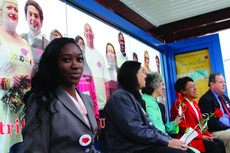The Rosa Parks Transit Center, a memorial to the civil rights legend and on-campus bus stop, was unveiled Feb. 25 at the new east gateway entrance to Mesa College.
Named the western branch of the Rosa and Raymond Parks Institute for Self Development in 1993, Mesa College is the first campus on the west coast to dedicate a public art project to Parks.
The Rosa Parks Transit Center along with the new parking structure, police station, Allied Health Building and east entry realignment mark the completion of the East Campus Improvement Project and the revitalization of Mesa.
“This is a monumental moment for Mesa College and our district,” said Walker.
Standing between the parking structure and Allied Health Building, the covered bus stop is bordered by highlights of Parks involvement in the civil rights movement, dedications to project contributors and a life size portrait featuring 12 current and former students.
“We represent the diversity and unity of the students of Mesa College,” said student Miguel Murillo, pictured farthest left in the portrait.
Adjacent to the bus stop are terra cotta colored, curved cement walls and a rose vessel embracing a rose inlay in the pavement. The walls read “Quiet Strength” and offer a space to reflect on the potency of Parks’ character.
Standing within the reflection area, the Mesa College Vocal Ensemble sang, “Rosa sat so Martin could walk. Martin walked so Barack could run” as part of the ceremony.
Parks sparked a yearlong boycott of the Montgomery, Alabama bus system when she refused to surrender her seat to a white male passenger and was subsequently arrested in 1955. Martin Luther King Jr. led this famous boycott causing the social revolution of the civil rights movement.
The quiet form of revolution Parks embodied combined with a movement towards green public transportation represents the past and future of Mesa College explained San Diego Mesa College President Rita Cepeda.
Parks first visited Mesa in 1992 coinciding with her 79th birthday on Feb. 5 thanks to a $10,000 contribution from former Mesa Professor Liz Hamilton. She returned in 1995 to speak to more than 2,200 school children from throughout San Diego.
A memorial was considered soon after Parks’ death in October of 2005. Three years later public artists Mario Lara, Nina Karavasiles and diversity expert Gerda Govine-Ituarte were awarded the chance to design the project.
Proposition S, passed Nov. 5, 2008, provided the $150,000 for the project.
Bus Route 44 began utilizing the stop Feb. 28.

